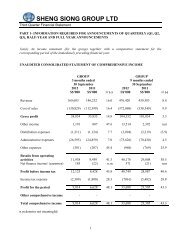FY 2011 Annual Report - Sheng Siong
FY 2011 Annual Report - Sheng Siong
FY 2011 Annual Report - Sheng Siong
You also want an ePaper? Increase the reach of your titles
YUMPU automatically turns print PDFs into web optimized ePapers that Google loves.
However, as we were consolidating in the years 2008<br />
to 2010 – we opened only one store each in 2008<br />
and 2009, and did not open any in 2010, the uplift to<br />
comparable same store sales from new stores was<br />
considerably less.<br />
Margins Improved<br />
<strong>2011</strong>’s gross profit margin ended at 22.1%, an<br />
improvement over 2010’s margin of 21.8%. The<br />
margin improvements came from lower purchase<br />
cost derived from increased volume of direct and<br />
bulk purchasing. This was made possible by the<br />
additional capacity and excellent infrastructure of our<br />
new distribution centre.<br />
Operations – Logistics<br />
We moved to our new distribution centre at Mandai<br />
in July <strong>2011</strong>. Following the move, space constraint<br />
was removed as the new distribution centre with an<br />
area of approximately 543,000 sq feet is four-and-ahalf<br />
times larger than the old warehouse. Now, we<br />
can increase our direct and bulk purchasing as well<br />
as improve our sales mix in favour of higher margin<br />
products like fresh produce and housebrands. These<br />
initiatives will enhance our gross margins. In addition,<br />
we have implemented a computer aided warehouse<br />
management and picking system, which has not only<br />
improved productivity but also paved the way for us<br />
to be less reliant on labour as we continue to build<br />
up our volume.<br />
Expenses<br />
Staff cost, which is the largest expense item in our<br />
operating expenses, was lower in <strong>2011</strong> because of<br />
the lower provision for bonus which varies with profits.<br />
Offsetting this saving were higher utility and IPO<br />
expenses. Rental of the supermarket outlets remained<br />
at about 2.5% of sales. Operating expenses were well<br />
controlled.<br />
Other Income<br />
There was an absence of one-time income like the gain<br />
in sale of investments, rental derived from subletting<br />
excess space at the Ten Mile Junction Supermarket<br />
and government grants in <strong>2011</strong>. In preparation for<br />
our IPO, we sold off our investments in listed equities<br />
in 2010 and will not be investing in such instruments<br />
again.<br />
<strong>Sheng</strong> <strong>Siong</strong> <strong>Annual</strong> <strong>Report</strong> <strong>2011</strong><br />
由于我们在2008年至2010年进行巩固、整合,我<br />
们2008年和2009年只各开一家店,在2010年则没<br />
有开设任何新店,所以来自新店的同一家店面销售<br />
增长便显得微小。<br />
毛利率改善<br />
<strong>2011</strong>年的毛利率报22.1%,比2010年的21.8%来得<br />
高。毛利率改善,是因为我们新的分销中心为我们<br />
提供额外的容量和卓越的基建,而直接采购和量购<br />
降低了采购成本。<br />
营运—物流<br />
我们在<strong>2011</strong>年7月搬到万礼的新分销中心。搬迁之<br />
后,我们不再受到空间的局限,因为新分销中心<br />
的总楼面约达54万3000平方英尺,是旧货仓的4.5<br />
倍。如今,我们可以增加直接和大批的采购量,以<br />
及通过引进赚利较高的产品如新鲜物产和自家产品<br />
来改良我们的销售品类。这些计划将提高我们的毛<br />
利率。此外,我们也推行了电脑化的货仓管理与拣<br />
货系统。这不仅提高了生产力,也为我们日后在继<br />
续增加货品处理量的同时减少对劳工的依赖铺路。<br />
开支<br />
我们营运成本当中耗费最高的员工开支在<strong>2011</strong>年有<br />
所降低。这是因为与盈利挂钩的分红准备金较少。<br />
另一方面,我们面对水电费增加和首次公开售股的<br />
开支。超市租金稳定,持续占销售额的大约2.5%。<br />
营运开支控制得很好。<br />
其他收入<br />
<strong>2011</strong>年,我们少了一些一次性的收入,如出售投<br />
资取得的收益、分租十哩广场超市的额外店面而收<br />
取的租金及政府给予的津贴。为了准备上市,我们<br />
在2010年卖掉挂牌证券,并且不打算再投资于<br />
这类工具。<br />
7



